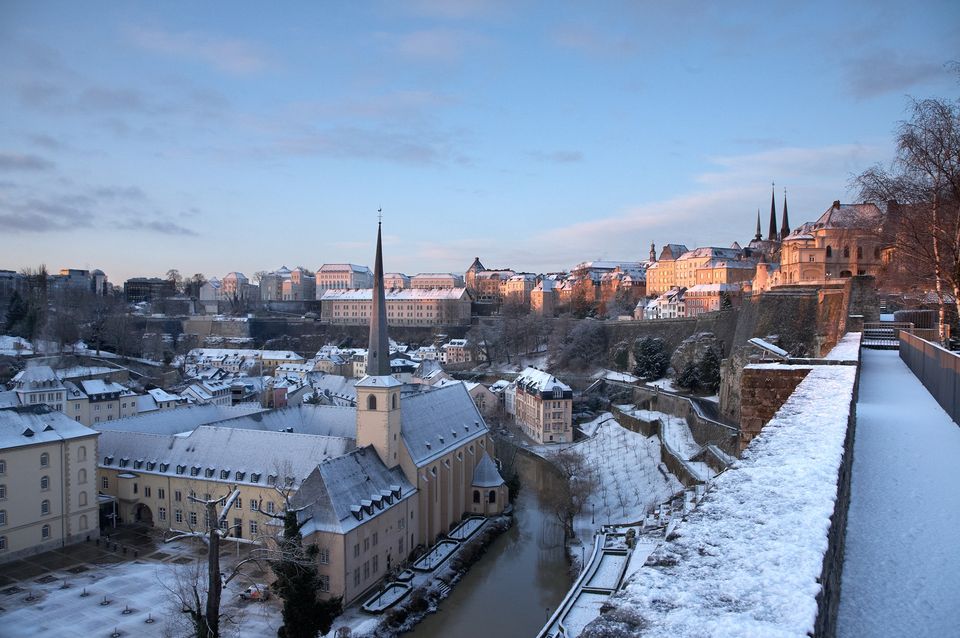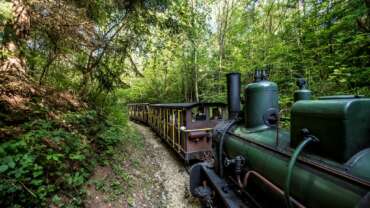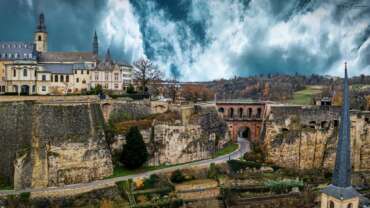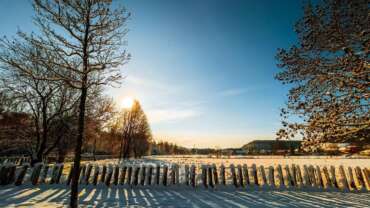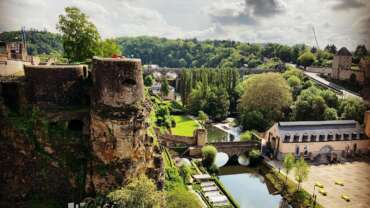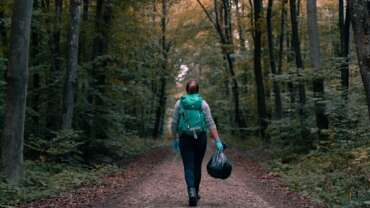Castles & Fortifications in Luxembourg
CASTLES, FORTIFICATIONS AND MEDIEVAL FESTIVALS IN LUXEMBOURG
Are you looking for an authentic fairytale destination?
Luxembourg is the perfect place for you with more than 50 castles and picturesque villages. Most of the castles have been restored to their former beauty and invite you to discover the rich historic past of the country.
The power of past Luxembourgish lords and lieges is evidenced by the various castles and fortifications in Luxembourg, remains of the Middle-Ages. Discover and visit not only the large restored castles (Vianden, Beaufort, Bourscheid, Bourglinster or Clervaux) but also the numerous majestic castle ruins revealing the myths and sagas of their time. Medieval festivals, culture, exhibitions and concerts offer excellent opportunities to discover the castles in a perfectly authentic setting in Luxembourg. Walking fans can follow the national hiking trail of the “Valley of the 7 castles” that runs through the idyllic Valley of Eisch in the western part of the country. There, one discovers the seven magnificent castles in a peaceful area with breathtaking landscapes and a spectacular culture offer. You can either drive the 24 kilometres route or follow the traces of the past on an exciting 37-km walk.
Alongside the little narrow streets of Luxembourg-city, you will make your way through the charming old town where the impressive Grand-Ducal Palace opens its doors to curious visitors during the summer months.
Wildlife & Nature
Would you like to change the climate, enjoy the beautiful nature, unique flora and fauna, to sunbathe on the coast of crystal lakes and noisy rivers and to ascend to the highest point on the planet, or ride across the desert?
Now it is possible. Visit Uzbekistan! The unique nature of Uzbekistan opens the entire palette of its colors of natural and pristine beauty to you.
Larochette Castle
The castle towers over this area and dominates the picturesque little town of Larochette (Fels in German). The buildings of the fortified castle, which dates back to before the 12th century, are perched on a promontory of Luxembourg sandstone, about 150m above the valley of the White Ernz, a tributary of the river Sûre. The oldest part of the castle is the Homburg Manor. It fell victim to a huge fire in 1565 and is still in ruins today. The Créhange Manor is the only building that has so far been fully restored. Temporary art exhibitions fill its historic walls with life. The many footpaths and mountain biking routes in the area offer excellent views over the whole castle complex.
Esch-sur-Sûre Castle
The first written evidence of Esch-sur-Sûre is found in the “Liber aureus Epternacensis”, the golden book of Echternach abbey according to which a certain Nebelungus is said to have donated his properties and serfs to the abbey. This act was written in the third year of Charlemagne’s reign, between 9th October 773 and 9th October 774. On 3rd June 927, Meginaud (aka Maingaud) acquired the site of Esch-sur-Sûre in a deal with the abbey of Stavelot. He erected an 8×8 metre square residential tower as well as buildings for agricultural use.
At the end of the 11th Century, the brothers Henry I and Godfrey I took part in preparations for the First Crusade and hence they could not work on the castle. The last two counts of Esch expanded their castle and its territory considerably. At the time the county of Esch-sur-Sûre included 19 hamlets and villages and extended down to Diekirch.
The first buildings of the castle were thus constructed in the Romanesque period, whilst its development took place in the Gothic period. With the advent of gunpowder in the 15th Century, it became necessary to adjust the defensive system. To this end the whole village was surrounded by a 450 metres long and 1.5 metre thick rampart with two defensive towers. The round watchtower was fortified at the same time.
The castle declined from the mid-16th Century to the 19th Century. After the capture of the fortress of Luxembourg in 1684, the troops of Louis XIV began dismantling the country’s strongholds. In Esch-sur-Sûre, the rampart was not destroyed because private houses were backing onto the walls. In fact some are still standing now, check out the lane next to the town hall.
By the mid 19th Century the castle passed into the hands of citizens who lived there. When Victor Hugo visited the village on the Sûre in the summer of 1871, the castle was still inhabited by several families. The chapel was restored in 1906. Today, only consolidated ruins are left to remind us of the proud history of the counts of Esch-sur-Sûre. The new illuminations give the castle a fairy tale look, well worth the detour.
Clervaux Castle
The majestic castle is perched on the slopes of a rocky promontory, the so-called “Lay”. The origins of the castle are lost in the mists of time. Some historians believe it was rising on a former Roman fort, while others believe it was built on celtic foundations.
The West wing is the oldest part of the castle, it was built in the 12th Century upon the initiative of Count Gerhard von Sponheim, a brother of the Count of Vianden. At the beginning of the 15th Century, under the reign of the powerful House of Brandenburg, Clervaux castle was greatly extended. To protect the southern flank of the castle, Frederic I built the massive Burgundy tower which also housed the castle jail.
Later, the living accommodation was improved, the cellars were converted and -more importantly- the mighty “Witch Tower” was built in the main courtyard for defense purposes. In 1634 Claude de Lannoy orders the redevelopment of the rather shabby dwellings and stables that extended to the north, and has them transformed into luxurious spacious reception rooms, including the Hall of Knights in the Flemish-Spanish style.
A quarter of a Century later, Albert Eugene de Lannoy added administrative buildings, stables and barns but demolished a local church. In 1671 a watchman’s lodging was erected at the castle entrance. Today this houses the castle’s café-restaurant ‘Au Vieux Chateau’.
In 1721 new stables were built to the left of the witches tower. Albert Eugene de Lannoy’s additions were demolished in 1887 and the recovered stones were used to build a modern mansion for the Count de Berlaymont in the park opposite the former castle.
From 1927 to 1930 the castle became private property. In the last throes of the second World War, during the Battle of the Bulge, the castle was badly damaged. Subsequently the Luxembourg State acquired the burnt out ruins and undertook a magnificent restauration.
The Family of Man
A venerable witness to a prestigious past, Clervaux castle now houses the offices of local government, the local tourist office, a marvellous collection of models of Luxembourg’s fortified castles, the Museum of the Battle of the Bulge exhibiting weapons and souvenirs from the 1944-1945 Ardennes offensive (Battle of the Bulge), and a most remarkable collection of documentary art photography, the “Family of Man” by Edward Steichen, consisting of 503 pictures by 273 photographers from 68 countries in an impressive setting of 37 themes, based on love and faith in man, depicting birth, work, family, education, children, war and peace, …
Bourscheid Castle
Bourscheid Castle and Gothic manor house
Bourscheid Castle is Luxembourg‘s biggest castle, an impressive structure with its characteristic round towers. The castle was probably built in the 10th century, and then extended in the 14th and 15th centuries, when the fortress wall was added, flanked by six Gothic towers. Nowadays, audio guides in seven different languages guide visitors round the castle. There are amazing views from the castle of the whole valley around Bourscheid. In the evening, the building is illuminated, creating a fairy-tale atmosphere. The nearby Stolzembourg House is a magnificent Gothic manor house dating back to 1348.
Bourglinster Castle
As early as 1098, the village of Linster is mentioned as a property of St. Simeon in Trier. An ancient castle was said to exist in Altlinster. At the time, the new castle consisted of a residential tower, a chapel and a rampart.
The husband and wife Beatrice Linster and Thierry de Fontoy, Seneschal of Luxembourg, received the castle as a fief of the Countess Ermesinde of Luxembourg in 1231. From the 2nd half of the 14th Century, the family of Orley lived in the castle. From this period dates the conversion of the chapel and the construction of a tower keep on the north side. In 1408 Jean d’Orley, provost of Luxembourg, is invested with the high court of Linster by Wenceslas II.
The construction of the lower castle (House of Waldeck) with moat, fortified gates and two defensive towers dates from the late 14th and 15th Century. In the 15th Century, Linster is divided between the families of Orley, Hammerstein and Bettstein. In 1476 Bernard of Orley II is mentioned as the adviser and chamberlain to Charles the Bold.
In 1477 Henry of Metzenhausen married Mary Antonetta Boos of Waldeck, heiress to a part of Linster. In 1527 Dietrich of Metzenhausen, governor of the Duchy of Luxembourg, marries Joan of Orley, and Charles V, Holy Roman Emperor, gives him Linster along with the high judiciary as a fief. Between 1542 and 1544, during the wars between Charles V and Francis I, both parts of the castle are largely destroyed.
As of 1548, the construction of the Renaissance wing on the south side was begun, keeping a wall of the residential tower. Between 1682 and 1684, French troops again destroyed parts of the lower castle.
During the 2nd quarter of the 18th Century, the baroque facade at the back of the courtyard was erected. In 1750 Eve of Metzenhausen married infantry captain Peter George of Zitzwitz receiving the fief of Linster in 1759. From the 18th to the 20th Century successive nobles and commoners own the castle until its acquisition by the Luxembourg State in 1968. Between 1969 and 1988, consolidation works, repairs and restoration of the castle and its outbuildings are undertaken.
In 1982 the association “Friends of Bourglinster Castle” was founded. They organise the Bourglinster Music Festival as well as exhibitions, concerts, lectures and receptions in the castle. The barns opposite the castle have been restored as art workshops. A renowned restaurant is within the castle walls.
Beaufort Castles
Beaufort Castles: medieval fortifications and Renaissance elegance
In the beautiful countryside of Beaufort, you can visit not one but two castles. Not far from the chateau’s idyllic little lake, an impressive medieval castle towers over the scene. It was built between 1050 and 1650. Following major repairs, the imposing ruins opened to the public as long ago as 1932 and today they are regarded as a historic monument. Just around the corner, you’ll find the Renaissance castle, which dates from the 17th century. The fascinating interiors bring the magic of the past to life. The castle can only be visited on a guided tour, which ends with an opportunity to taste the chateau’s famous Casséro liqueur.
Ansembourg Castle
Built from the first half of the seventeenth century as “House Forges” by Thomas Bidart, pioneer iron industry, the Grand Castle Ansembourg experienced a significant transformation in the eighteenth century, when the heirs of Thomas Bidart found themselves elevated to Baron (1728) and Earl of Marchant and Ansembourg and Count of the Holy Roman Empire (1749-1750).
The gardens were laid out in 1750 and are adorned with statues, stairs and decorative fountains in the garden style regular time.
Vianden Castle
Vianden Castle: an outstanding historical monument
Vianden Castle is a real magnet for visitors, being one of the biggest and most beautiful feudal residences from the Romanesque and Gothic periods. The castle was built between the 11th and 14th century on the foundations of a Roman castle and a Carolingian refuge and for a long time belonged to the Grand Ducal family, before passing into state ownership in 1977. Since then it has been restored to all its former glory. Today, Vianden Castle is one of Europe’s leading historical monuments. There is a modern, interactive visitor centre in the entrance area.
Bock Casemates
Bock Casemates: a UNESCO World Heritage Site
The Bock Casemates, a subterranean defence system made up of kilometres of tunnels, is today one of the most important visitor sites in Luxembourg. These underground galleries were initially carved in the 17th century, under Spanish rule, and subsequently twice extended. Visiting the archaeological crypt, the antechamber to the casemates, is a similarly remarkable experience. On account of these impressive fortifications, Luxembourg was even given the epithet of the “Gibraltar of the North”. Discover the tumultuous history of the casemates and take in wonderful views of the Grund, Clausen and Pfaffenthal districts.
Brandenbourg Castle
Brandenbourg is crowned with the ruins of a castle whose origin goes back to the 10th century.
Grand Ducal Palace
As the town residence of the Grand Duke, the grand-ducal palace has unquestionably one of the most beautiful façades in the city (Flemish Renaissance, 16th century). Majestical interior and splendid above stairs (with light design by Ingo Maurer) can be visited exclusively during summer.
Hesperange Castle
The locality of Hesperange was first mentioned in 867 / 868 by the name of Hasmaringa marca and was owned by the abbey of Echternach.
The gallows in Howald as well as a pillory located near the castle until the late 18th Century were mentioned as early as 1277. The castle walls to the west of the keep extend to 18 metres.
It’s likely that the counts of Luxembourg gave the fief of Hesperange to the lords of Rodenmacher in the early 13th Century who erected a castle on this strategic site. When the Burgundians conquered the Duchy of Luxembourg in 1443, the lords of Rodenmacher sided with the French. After several battles between Gerard of Rodenmacher against Archduke Maximilian of Austria, husband of Mary of Burgundy, the latter dismantled the castle of Hesperange not just once but twice, first in August 1480 and again in May-June 1482, only to transfer it on 15th November 1492 to his cousin Margrave Christopher of Baden.
The Lords of Baden -who led the high life- had to pawn the lordship of Hesperange on 29th December 1632 and could not reclaim it until 1740. On 25th July 1796, French revolutionary troops took possession of the castle and the seigniory of Hesperange.
On 25th May 1798 the castle was nationalised by the French government and sold at auction. Subsequently, various parts of the ruins were sold and by 1820 seven houses stood in the grounds. In 1984, the Luxembourg State listed the ruins on its inventory of national protected monuments. They are still owned by private individuals.
Hollenfels Castle
Perched on a rocky spur at a height of 315 m, Hollenfels Castle – which forms part of the “Valley of the Seven Castles” – overlooks the narrow Eisch Valley, offering impressively beautiful views.
Hollenfels Castle is made up of a keep, which is nearly 40 m high, an angular tower, a curtain wall and a main residential building. It can be reached by a brick bridge leading over the defensive ditch.
Youth hostel and ecological centre on the domain of Hollenfels Castle.
Koerich Castle Gréiweschlass
Situated in the Goebelange brook valley, the castle of Koerich is a typical example of our lowland castles. With its impressive tower and its exterior walls arranged in an almost perfect square, it forms a remarkable unit with Koerich’s baroque church and old houses. Wirich Ist, Lord of Koerich, Seneschal of the court of Luxembourg, started building the castle in the late 12th and early 13th Century. The tower – known as ‘witches tower’ – and the exterior walls are of late romanesque style. It has a 12 x 11.6 m base and a thickness of 3 to 3.5 meters, and -though currently only 11 metres high- its estimated original height of 25 to 30 metres made this one of the most imposing towers in our region. A reconstruction in the Gothic style took place in 1300.
Today, only the south-west tower remains. The chapel, dedicated to St Michael, is on the ground floor hence its name ‘chapel tower’. A guards room was on the 1st floor.
In 1728, the southern wing was rebuilt in the Baroque style. After the 2nd half of the 18th Century, the chateau was no longer lived in, and hence -due to lack of maintenance- it eventually became uninhabitable. In the early 1950s the last owner, Mr P Flammang, undertook building works to safeguard the crumbling structures. Currently, the ruins are owned by the Luxembourg State.
Mersch Castle
The first lord of Mersch, Theodoric, appears in a 1232 text as: “Miles, dictus of Maresch, dapifer comitissae de Lucenburch”. He is a knight and vassal of Countess Ermesinde. In this document a “Turris” is mentioned. This tower is most likely the keep. The alignments of the stones reveal two construction periods.
Theodoric built a new castle with a moat. The Burgundian troops stormed this castle and burned it down. In 1574, the owners drew up a plan for building a new castle. Its dimensions were 61 by 70 metres, the moat was 11 metres wide, the enclosure wall was 1.35 metres thick and was flanked by seven towers. When Paul von der Veltz became sole owner in 1585 he fitted large windows in the keep, transforming the building into comfortable living accommodation…
In 1930 the then owner Mr. Uhres, undertook a restoration, and in 1938 the structure was converted into a youth hostel.
The town council acquired the castle in 1957 and three years later it was handed over to the state. As soon as 1988, in an exchange between the state and the council, the castle once again came into the council’s ownership. The renovated building became the town hall in 1993.
The castle is the town hall of Mersch; for this reason it is not accessible to the public.
Mont Saint-Jean Castle Dudelange
The Mount St John
Since time immemorial, Mount St John has been a spiritual site. The church dedicated to Saint John the Baptist was the mother-church for the surrounding parishes.
From 1464 to 1542 the Mount was the seat of the Order of the Bretheren of St. John of Jerusalem. Due to their large income, (the great tithes) seven priests could accommodate and feed seven destitute parishioners.
Even after the destruction of both castle and church, St John’s day (on June 24th) remained an important holiday. Up until 1794 a hermit lived on the mount and read mass in the chapel.
In his ‘Historia Luxemburgensis’ Jean Bertels -who later became abbot of Echternach- described a procession taking place in the 16th Century in honor of St. John. It was famous for drawing vast numbers of faithful pilgrims to the mount. Many afflicted would dance to various tunes to the point of exhaustion, in this way imploring the help of Saint John for a cure. Note the striking similarities with the dancing procession in Echternach.
The festival was often accompanied by a market on the mount, as revealed in archive texts and through excavations in which many coins and pottery fragments were found. Nowadays, the annual procession of St. John reminds us of this centuries-old tradition.
The Castle
At present, we don’t have any definite data neither about the origins nor about the appearance of the first castle on Mount St. John. Excavations have revealed Gallo-Roman substructures below the medieval fortifications.
The first castle belonged to the lords of Gymnich and was located in Dudelange. It was destroyed around 1400 by the Duke of Bar.
The construction of the castle had begun in the early 15th Century. The walls uncovered during the excavations show significantly different construction periods culminating in the castle of the 16th Century (Gothic and Renaissance).
The square stone blocks and reliefs show that the Lords of Gymnich, Boulay, Neufchatel, Hunolstein and Isenbourg invested heavily in both the fortifications and the luxuries of their castle. Various documents describe it as a very ‘strong place’ -a mighty castle- famous for its feasts. It deteriorated dramatically when from 1542, the kings of France François 1er and Henry II made war on Emperor Charles Quint (Charles V) when it was conquered and reconquered many times before its final destruction in 1552 after which it lost any strategic value.
Subsequently, the ruins were used as a quarry for the nearby villages. In the 1970s, the Friends of History of Dudelange and Mount St. John dug out the remains of the castle and uncovered the foundations of various towers, the palace, houses, stables and outbuildings; three wells and a cistern were partially excavated. The moat and the access to the castle are still visible.
However, the castle still holds many legendary secrets like that of the Virgin of Mount St John, who -transformed into a snake- awaits her saviour every seven years.
Petrusse Casemates
Their origin goes back to 1644, when the Spaniards reinforced the medieval fortifications. Under the supervision of the Swiss fortress builder Isaac von Treybach, they built – among other defence works-the powerful Beck Bastion, named after Governor Baron Johann von Beck, a native of the city who had played a key role in the Wallenstein affair on the side of the Emperor. Initially this bastion was as high as the adjacent terraces on the right; it was raised to the present level of Constitution Square (the wall is 27 meters high) by Vauban in 1685. In 1673 the Spaniards erected the so-called “Ravelin du Pate” to strengthen the defence of the Beck Bastion; this triangular construction is one of the few well-kept fortifications. Marshall de Vauban conferred the present shape to all the Petrusse fortifications and built the “Small Staircase”. From 1728-29 the Austrians added the “Bourbon Lock” and the “Large Staircase” and in 1746 the casemates of the “Petrusse Battery” (54 gun emplacements). One century passed and the fortress was enlarged and reinforced: the second ring was extended and the third started, so that Luxembourg became the “Gibraltar of the North”. By and by, the Petrusse fortifications fell into oblivion and neglect, as their strategic momentum limited itself to the valley. After the dismantling, stipulated by the 1867 London Treaty, they confined themselves to walling up the loopholes and most entrances. Only in 1933 were the Petrusse casemates valorized again: on 26th July, the first visitors were able to visit them.
Pettingen Castle
The beautiful ruins testify to the power of the former castle. In the 10th Century the fortress of Pettange was known by the name of ‘Pittigero Mazini’ which by the 13th Century had become Pettange or Pittange.
Throughout the Middle Ages the names of the lords of Pettange are connected with Luxembourg’s major events e.g. the wedding of Ermesinde, the accession to the throne of Henry IV, and the marriage contract of Count John the Blind.
The first land registry of 1824 reveals the state of the castle: Buildings still in use at the time were attached to the four outer walls. Southwest of the castle stood a larger building, which has now completely disappeared. In 1850, the historian Engling notes the decline of the castle.
In 1910, the then owner, Prince of Arenberg had anything of value removed from the castle. In 1920, the south facade collapsed. The castle was used as a quarry.
Schengen Castle
Schengen Castle (1812, housed a hotel) with its 13th century tower, its baroque garden and its herb garden is privately owned by the Guy Rollinger group and cannot be visited at present.
Schoenfels Castle
The hamlet of Schoenfels is first mentioned by the name of Scindalasheim in a deed of 846 as a gift by Bishop Hetto of Trier to Abbot Marcuardus of Prüm.
In the 12th Century a person by the name of Theodorius of Schonevels is known. In 1292, before the invention of artillery, a fortified farm (primitive castle) was erected by a certain Ferri, aka Frederic of Schoenfels. It passed by marriage to the lords of Ansembourg, and later to the Sassenheims.
In the early 16th Century, Henry Schloeder von Lachen, Lord of Schoenfels and Busbach, acquired the estate. The Schloeder von Lachen coat of arms decorates the entrance to the tower.
The feudal castle of Schoenfels -of no great strategic value- was stripped of its fortifications by the French Army in 1683…
Schuttbourg Castle
Near Kautenbach, Schuttburg castle dating back to the 12th century.
Useldange Castle
The division of estates created the lordship of Useldange around the year 1100.
The first Lord was Theobald of Useldange and his wife Azeka. This dynasty became extinct around 1250. John of Rodemacher becomes the legitimate lord of the manor by his marriage to Irmgart of Boulay in 1415. Due to intrigues in the course of the war between France and Burgundy the Rodemachers didn’t survive for long. Maximilian Ist confiscated Useldingen in 1479 and handed it over to Christopher of Baden. As a result of these upheavals, the castle and chapel suffered serious damage. William of Nassau-Vianden inherited the stronghold only to sell it to François Sebastian Bauer of Everlange in 1674. There follows a period when the feudal castle falls into total ruin ending up as a stone quarry. The chapel was demolished in 1903.
Mrs Kuhn-Wolff, a native of Useldange who had emigrated to the United States at the age of 18, purchased the ruins in 1924 and returned to Useldange to renovate the castle. Although the new owners started strengthening the walls and the keep, they did not respect the original architecture and by 1934 the large entrance gate and palace were replaced by a modern villa which is used today as the town hall.
A cultural itinerary for the partially sighted
A trail for partially sighted visitors has been set up under the patronage of UNESCO. It leads around the castle and inside the tower and presents local culture in sixteen stages. The partially sighted are literally offered the opportunity to feel, hear and touch History.
The cultural itinerary also aims to present the local wildlife and integrates the aromatic herbgarden to encourage visitors to discover the great variety of local plants and herbs – well marked by specially designed pannels for partially sighted visitors.
Septfontaines Castle
The exact time of the first castle in Septfontaines, is no longer observed. What historians know that in 1192 appeared a certain Tider as Lord of Seven Born in a document on. In 1233 presents John of Septfontaines his property under the rule of the country Princess Ermesinde.
At the beginning of the 14th century, Thomas Siebenborn, the friend and companion of Emperor Henry VII., was the lord of the manor of Septfontaines.
1600 Christoph von Criechingen built at the northern entrance a massive renaissance tower.
The castle is privately owned and not open to visitors.
The Former Castle of the Counts of Luxembourg
The name Luxembourg was first mentioned in 963 when count Siegfried exchanged lands for a small fortified castle by the name of Lucilinburhuc.
Throughout the Middle Ages, the House of Luxembourg considerably extended its territory and power. Between 963 and 1443 Luxembourg was independent, at first as a County, then since 1354 as a Duchy. In the 14th Century and the first half of the 15th Century, four Holy Roman Emperors and four Kings of Bohemia came out of the House of Luxembourg.
Thanks to its strategic position in Europe and its formidable fortress – referred to as “Gibraltar of the North” – Luxembourg was much coveted. Thus -between 1443 and 1815- the castle of Siegfried had to endure a succession of Burgundian, Spanish, French and Austrian rulers who each shaped the fortress and the surrounding countryside.
After the defeat of Napoleon, the Powers of the time gathered at the Congress of Vienna in 1815 to reorganise Europe. Due to the importance of the fortress they decided to create a new country around the fortified castle on the Bock: the Grand Duchy of Luxembourg.
By strategic calculation, the king of the Netherlands was appointed in personal union as Grand Duke of Luxembourg and at the same time Luxembourg became part of the German Confederation, its capital a federal fortress. At the 1867 Congress of London Luxembourg was declared “perpetually neutral”. This meant that the Prussian Garrison had to withdraw from the fortress of Luxembourg which was to be dismantled, an operation that took 16 years.
In 1890, the dynasty of Orange-Nassau lacking a male heir, passed the crown of Luxembourg to the Nassau-Weilburg which meant that the Grand Duchy once again had its own dynasty. The Grand Duke’s official residence is within walking distance of the ancient castle of the counts of Luxembourg.



